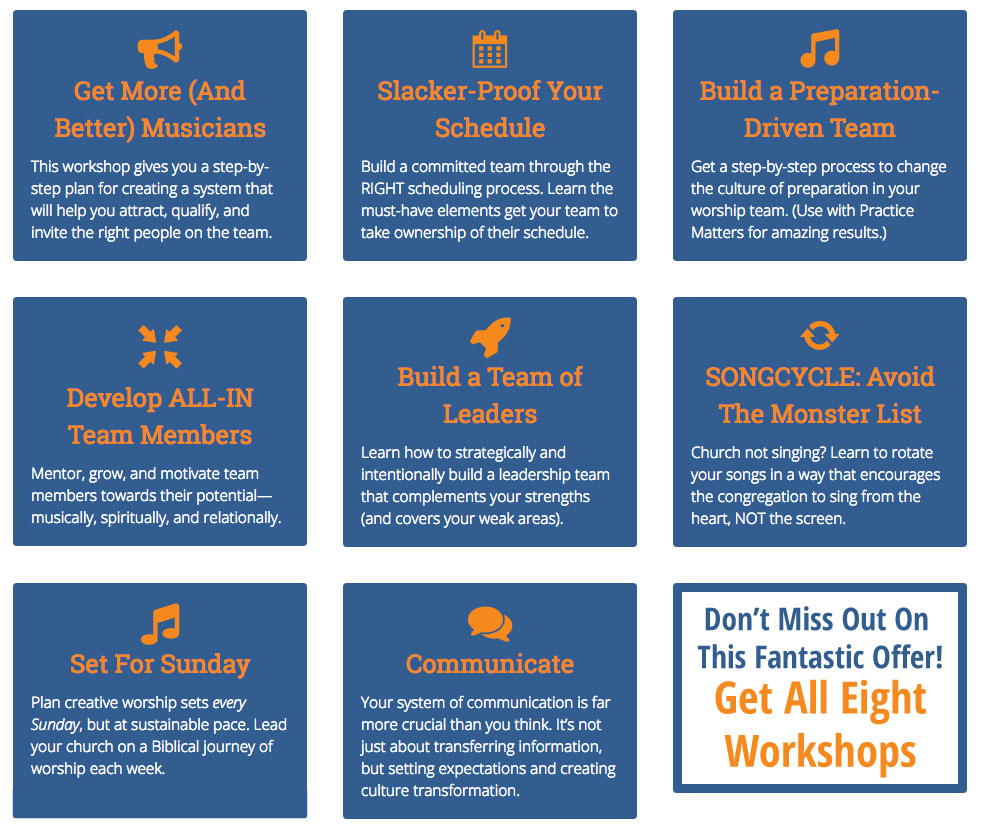Get this FREE Resource Bundle that includes all sorts of good stuff...
7 Strategies to Lead an Artistically-Driven, Administratively-Challenged Worship Leader
What to Do About Kyle
Not every artistically-driven worship leader is also administratively-challenged. But...
"Anyone know where Kyle is?" Dean asked, trying to keep the edge out of his voice.
Dean hired Kyle about six months ago to fill a long-open worship leader vacancy. In that time, Kyle brought new life and vitality to their worship services.

The band was already solid for a team of all volunteers. But Kyle's creativity and sensitivity to the Spirit had bolstered the quality of Sunday—to levels Dean thought would take years to get to.
But, dang. Would the dude ever show up on time for a staff meeting?
"I'll text him," offered Emma, the student pastor.
About three quarters of the way through the team devotional time, Kyle sauntered in. "Sorry. I was working on the tracks for the community night of worship. Didn't realize the time."
Dean's sanctification kicked in just as sarcasm almost slipped out. Instead, he gave a half-smile and nod at his worship pastor and kept going with the devotional.
But for the remainder of the meeting, Dean kept thinking this: What am I going to do about Kyle?
It wasn't just showing up late to team meetings. Dean had heard of more than a few missed appointments with other staff and worship team members.
 Kyle is an administrative train wreck.
Kyle is an administrative train wreck.
He gets lost for hours in the tedious details of creative and musical work. But then drops the ball—or seems unconcerned—about on the critical tasks required to run a church ministry department.
If it wasn't for the admin assistant Kyle shared with Emma, the worship ministry would run off the rails.
Dean had to figure out how to lead an uber-talented, creative genius who didn't have an administrative bone in his body.
And he had to figure it out soon.
Your Artistically-Driven, Administratively-Challenged Worship Leader
Does any part of Dean's dilemma ring true for you? Then congratulations! You have an artistically-driven, administratively-challenged worship leader.
 There's a good chance Mars and Venus are more alike than you and your worship pastor. You're more like Mercury and Neptune.
There's a good chance Mars and Venus are more alike than you and your worship pastor. You're more like Mercury and Neptune.
So if you want to lead your creative staff person well, it will test your leadership chops.
I can't give you an exhaustive "how-to" for overseeing a creative worship leader. Creatives can't be reduced to one personality type or gift mix. And so there's no one-size-fits-all solution to guide them towards personal and leadership growth.
But what I can give you are seven action strategies to help you lead your creative. These strategies are ways of entering into specific challenge areas to help your worship leader grow.
These strategies won’t give you every step of the journey, or every tool for the climb. But if you take action with these seven strategies, you'll have a better chance of helping your worship pastor develop personally and grow as a leader.
In some cases, these seven strategies may require you to change your thinking or an approach you've been taking. Other ones will just be a good reminder of something you already know.
As we talk about these strategies for leading creatives, I'll dig into typical areas where most creative worship leaders struggle and give you some practical tips and ideas. But more importantly than any tips or tricks, I hope this article will be a catalyst for transparent conversations between you and your worship leader.
First, a few housekeeping items:
- Paid vs. Volunteer. If your worship ministry leader is a volunteer and not a paid staff person, you can adapt most of this content for him or her. And speaking of him and her...
- Him vs. Her. Creative worship leaders come in both varieties. So at times, I'll use male pronouns, and other times I'll use female pronouns.
- Titles. Also, I may use different titles: worship leader, worship pastor, creative arts director, creative staff, or the thorn in your flesh. (I'm kidding about that last one. But admit it, you kinda liked it.)
- Bonus Tools. And finally, since this is such an in-depth article, I've created an ebook version and supplemental guide to with it. You can download that here.
(And hint: there might be a free leadership assessment in there, too.)
You may find some of these strategies more helpful than others for your situation. Since I go fairly deep with each of these strategies, here are links so you can navigate to each section (and back).
The Seven Strategies to Lead Your Artistically-Driven, Administratively-Challenged Worship Leader:
- Fight the Right Battles
- Give Direct Feedback (But Allow Space to Process)
- Establish Boundaries; Allow Flow
- Kill Perfection
- Encourage Systems (And Other Things They're Allergic To)
- Grow the Leader (Inside the Artist)
- Develop Discipline (Without a Lobotomy)
Strategy One: Fight the Right Battles
Two years into my first full-time vocational ministry position, my senior pastor came to me in defeat:
"I don't understand. I don't see how you can let your desk be so messy. But I'm tired of trying to get you to keep it clean."
BOOM! I won!
OK, I didn't. There was no winner.
I resented his constant hounding. He hated my disheveled desk. To him, it was a sign of an undisciplined life. He was right about that. I was undisciplined. But his attempts to "fix me" frustrated both of us.
Looking back, I can see so many areas where he could have mentored me and helped me grow as a young assistant pastor. Charged with leading both the worship ministry and youth ministry, I was entirely out of my depth.
He knew it, but he fought the wrong battle.
I'm not sure if my cluttered desk was a symptom of a deeper issue or just part of how I'm wired. Almost two decades later, my desk is still a mess.
But had he taken me under his wing and taught me how to run the administrative systems of my youth and worship ministries, things would have been different.
As you're thinking about your creative staff person's growth areas, pray for discernment. Which issues should you address, and how?
You might have a whole laundry list. But choose to fight the right battle, right now. Look for the issues that, once addressed, might make tackling the other ones easier for both of you.
Charles Duhigg, in his book, The Power of Habit, talks about the power of “keystone habits” to build other habits.
“Keystone habits start a process that, over time, transforms everything.” (Charles Duhigg, Kindle location 1597)
For instance, let's say your creative worship leader forgets appointments. At first battle, it might seem best to help him create some simple habits:
- Schedule out his day.
- Enter all his appointments in his phone.
- Set up notifications to pull him out of his creative work for each appointment.
But the keystone habit might be this:
Help your "Kyle" establish a 2-minute morning routine of reviewing his calendar as the first activity of his workday.
This 'ritual' will also create a space on which other good habits to be piggybacked:
- Setting up appointment notifications.
- Scheduling his day.
- Reviewing his goals.
And knowing that he will review his calendar each day, that will trigger more diligence in entering appointments as they come up.
Unorganized people desperately need rituals and routines. Organized people gravitate towards those. But when an unorganized person can lock in a positive ritual, routine, or habit, it's literally life-changing for him or her.
Now, as you're guiding your worship leader towards behavioral change, watch for signals of underlying attitude issues.
Going back to Kyle, subconsciously, (or consciously), he resents the time he spends in meetings.
- He's bored by all the talking.
- Meetings keep him from his 'real work.'
- And when he does try to contribute in meetings, he gets frustrated when people dismiss his ideas or don't seem to understand them. (More on why this is later.)

Entering dates into an iPhone calendar won't change Kyle's resentment for meetings. But if Dean keeps a watchful eye while fighting the right behavioral battles, he's going to uncover the deeper issues perpetuating Kyle's undisciplined work.
So to ultimately help Kyle, Dean has to strategically choose the best battle that will indirectly win other battles.
Would you rather read this article as a PDF? Or print it for "analog" reading? Get this FREE Resource Bundle that includes all sorts of good stuff...
Strategy Two: Give Direct Feedback (But Allow Space to Process)
The next leadership strategy is focused on how you give feedback to your creative worship leader. Creatives, more than the average person, define their identity by what they produce. Their work is truly a part of them.
When you criticize your worship leader’s work, you're criticizing her personally—at least in the moment. She needs a little space to untangle the valuation of her work with her innate value as a person.
Here are a few tips that might help:
- Value vs. Worth
Remind your creative worship leader often of the value they contribute to the church and your team. But also make sure she knows her worth isn't based on what she produces. She needs to know you value her as a person.
- Ask before offering critique.
When critiquing a worship service or anything else she’s produced, ask your worship leader how she thought it went. Often, creatives are far more critical than the rest of us. She may already see what didn't measure up.
- Clear is kind.
When you need to give constructive feedback, it's tempting to use kid gloves—especially when they've been overly sensitive to critiques in the past. But as Brene Brown says, “Clear is kind.”
Your creative needs to know specifically what didn't work and why.
- Now or later?
After you offer the feedback, give her the option of talking about it now or waiting until later. If you know she's an internal processor, you probably need to opt for later to give her space to process the critique. She'll need time away from the conversation to unravel it and piece it back together.
Early in ministry, my senior pastor accused me of "not listening" when he gave me critical feedback. I can't recall what his reasons were—I wasn't really paying attention.
(OK, admit it, that was a little funny...)
In reality, I suspect my immediate responses were less than satisfactory to him. Looking back, I didn't yet have the maturity or self-awareness to say something like, "I hear what you're saying about _____. I need a little time to think and process it."
So help your creative worship leader by giving her permission to ask for some space to process after you’ve given her constructive feedback.
Take a Hint?
At the risk of stereotyping, here's a tendency that makes receiving feedback difficult for some creatives: they don't always pick up on subtle cues and hints.
She might just be in a scattered or distracted moment. Or she could just be that socially-awkward artist. Either way, some creatives require you to be painfully clear on what you expect. And even then, you should ask them to summarize what you said.
Speaking of not understanding...
Creative (Speech) Block
Sometimes artists have trouble expressing what they mean. Their creative vision is a gray matter montage of images and ideas only they can see. It can be frustrating to try to translate their kaleidoscope vision into language others will understand.
So have grace for your creative staff person and ask clarifying questions to help her tease out what she's really thinking. This is another way to give them space to process:
Don't assume you know what she means from the first thing she says.
As someone who communicates with people for a living, you probably find this maddening. But remember, getting from Mercury to Neptune will require a few indirect orbits and the occasional asteroid field.
Strategy Three: Establish Boundaries, Allow Flow
This strategy will allow you to help your creative worship leader better manage their workload.
To do their best work, you know everyone on your staff needs uninterrupted blocks of time. But the artistic person needs more.
Creative production requires flow. Even a short interruption derails the endeavor. One researcher said it takes an average of twenty-three minutes after an interruption for someone to resume the task. [Learn more here.]
But that doesn’t account for the time it takes for the creative person to re-enter that deep state of focus. We’re talking hours of lost productivity each week from a few small interruptions.
Let's go back to Kyle for a moment. Here's what interruptions are like for artists:
Emma, the student pastor, 'pops by' Kyle's office.
"Hey, knock-knock, Kyle! Quick question—do you mind helping me pick out the songs for the student night of worship coming up?"

Kyle looks up from his Mac at Emma, almost like he didn't hear what she said. Mostly because he didn't.
"I'm sorry, Emma, what was that again?"
Emma repeats the question.
Kyle agrees, "Sure, I should have some time tomorrow afternoon."
Emma bounces off back to her office. Kyle's nose goes back to his MacBook.
At the most, it was a fifty-eight-second exchange—for Emma, the interrupter.
For Kyle—the 'interruptee'—it might as well be fifty-eight MINUTES.
Think of Kyle doing deep, creative work like a scuba diver searching for sunken treasure 50 meters below the surface.
This "small" interruption by Emma required him to leave those depths, swim to the surface for the exchange, and then swim back down and attempt to find where he left off in his search.
If you're not wired like this, it's hard to imagine. But for some creatives, deep flow is critical and not easy to find without solitude.
This hyper-focused state allows creatives to produce amazing things. But it's also their curse.
Unless something pulls them out, they'll miss appointments, forget to pick up their kids from school, forego sleep, and sometimes food. Dean has experienced this with Kyle, this obsessive-focus that trumps everything.
So how do you deal with this blessing/curse of ultra-focus?
If your creative gets lost in his work, or he’s is frustrated because he can't focus because of too many interruptions, here are some steps to try:
Create Structured Time Blocks
Guide your creative worship pastor to structure his workday with two to three 90 - 120-minute blocks of work.
Designate Distraction-Free Zones
Determine which times can be interruption-free and when he has to allow for interruptions from other office staff. That will help him manage his expectations.
 I took a lot of flack from my church office team when I started guarding distraction-free blocks of time. I got razzed for hanging a Do Not Disturb sign on my door, and the receptionist tried to have the ‘send-to-voicemail’ function forcefully removed from my office phone.
I took a lot of flack from my church office team when I started guarding distraction-free blocks of time. I got razzed for hanging a Do Not Disturb sign on my door, and the receptionist tried to have the ‘send-to-voicemail’ function forcefully removed from my office phone.
I get why.
We had been planted out of a church that had a "perpetually-open door" culture. I worked for three years at 'the mothership' led by a senior pastor who thrived on personal interaction.
Throughout the pre-plant years, anyone could walk into my office with their agenda. Even worse, our phones had an intercom feature from the pit of hell. Someone could interrupt another staff person from the comfort of their own office—without even the courtesy of a ring.
I was miserable. I felt like I was yanked continuously to the surface by all those interruptions.
When we launched the church plant, I finally had the blessing of my new senior pastor to guard blocks of my time. (Mostly because he shared the same frustrations of our previous office culture.)
One of the best gifts you can give your creative is to protect his need for uninterrupted space. (This might require chaining the student pastor to his desk so he can't challenge your worship pastor to a foosball match every afternoon.)
Obey the (Parkinson's) Law
Now, the guarded time blocks won't benefit your worship leader or the church if he doesn't understand and obey an immutable law of time management:
Work expands to fill the time allowed for their completion. [Learn more here.]
In other words, your creative’s workflow will overflow if he doesn’t contain it. While eliminating unnecessary interruptions is crucial, your worship leader also needs boundaries and guardrails to ensure he completes his work.
Guide him to create time limits for his tasks and projects. At first, you might have to offer accountability. But as he discovers the power of these self-imposed deadlines for higher productivity, he'll likely embrace them.
When it comes to establishing boundaries and applying Parkinson's law, some creatives need to learn to say, "good enough." That's your next strategy.
Want this article as Ebook? You'll also get the Guidebook and a Leadership Assessment. Get this FREE Resource Bundle that includes all sorts of good stuff...
Strategy Four: Kill Perfection
For many senior pastors, it's a battle to get their staff and volunteers to value excellence the way they do. But not for the creatives. In fact, you’ll have to pull back on the reins occasionally.
The artistically-driven worship leader likely over-delivers on the excellence factor of his creative endeavors. While exceptional quality is important, he can't be allowed to achieve those standards at the expense of his other work—the vanilla flavored, non-creative, get-it-done-for-Sunday tasks.
The weekly nature of planning, preparing, and leading a worship service requires realistic production standards. No matter how big or well-staffed a church is, every competent church leader knows there's a "good enough" stopping point.
After that, the law of diminishing returns kicks in.
For example, a creative worship leader spends hours recording his own enhancement tracks for a pre-sermon song. He insists it's necessary and far superior to the pre-made one he could buy for $7.
But this song is a “one-and-done” and won't go into regular rotation. And you and I both know the truth: no one from the congregation will hear the difference.
The purchased track is 'good enough.'
This may be an area where you need to mentor your creative worship leader. Help him understand what's 'good enough' for your church and avoid the never-ending, "perpetual perfecting" of a project.
Critical Perfection
If your worship leader struggles with perfectionism, it's not just affecting time management.
Perfectionistic creatives are often overly critical of themselves and others. Their strengths—creativity, an eye for aesthetics, musical intellect—become a liability when they're deriving their identity from their art.

If you see deep-seated issues of identity, invest in a counselor or spiritual director to help your worship leader get to the root of why he's identifying too closely with what he creates.
If you see mild tendencies towards perfectionistic-driven criticism, a good leadership coach can help your worship leader recognize those issues and take steps to change. [Learn More Here]
As you work to "kill perfection,” don't expect an enthusiastic reception. When you ask your creative to throttle back his standards to 'good enough,' he'll act like you're jabbing his baby with a pointy stick.
In a way, you are.
So if reason won't work, you might have to let him fail. Sometimes only a bitter experience of wasted time and effort on an overproduced project can teach the truth about the law of diminishing returns.
At that point, he'll finally believe you: good enough really is good enough.
Strategy Five: Encourage Systems (And Other Things They’re Allergic To)
The next leadership strategy is probably more of a reminder for you. But it could be a massive shift for your creative:
She needs to understand the power of systems.

In one of my first pastoral experiences, I remember somebody talking about the need for intentional systems. I was feeling quite Christian that day because I judged this person to be untrusting of the Holy Spirit. And probably a closet-pagan.
Other times, when the topic of systems came up, I dismissed them as "not for me."
Why?
I...was an artist.
I...was spontaneous.
I...could not be constrained by artificially construed boundaries.
I…was a complete tool.
A Catalyst Conference message from Andy Stanley opened my eyes to the need for systems. Before hearing Andy’s message, I had been reading leadership book after leadership book and feeling like I didn't have what it takes to be a true leader.
But understanding systems changed everything for me.
Through the years of building up my own worship ministries and coaching other worship leaders, I recognized that there are eight essential worship ministry systems. Four are focused on Sunday, and four are focused on growing the ministry.
The Sunday-Focused Systems are...
- Scheduling:
The process of creating your team schedule (rotation/roster), and the expectations for individual team members to respond appropriately to scheduling requests. - Preparation:
The processes, events, and expectations for the team to be musically and spiritually ready for the worship services. - Set/Service Planning:
The process for selecting the songs, scriptures, segues, and other worship elements, and then crafting the flow of the sets and/or full services. - Song Rotation and List Management:
The process of managing a healthy song rotation which promotes active participation by the church. This is the critical system to grow a church that sings.
The Team/Ministry Focused Systems are...
- New Team Member Qualification & Onboarding:
The process of attracting, qualifying, and inviting the right people into the ministry, and then ensuring their success as a new team member. - Team Member Training/Development:
The discipling process to teach team members the skills, knowledge, and character they need to be successful worship ministry members. - Leadership Development:
The process for identifying, training, and deploying leaders in your ministry and from your ministry. - Culture/Communication:
The processes for creating and communicating vision, values, expectations, and policies with team members, as well as managing the distribution of critical team information: schedules, charts, and recordings, etc.
Now, whether your creative worship leader knows this or not, she already has all these systems in her ministry. And each of those systems is perfectly designed to be getting the results they're getting:
- If her team members show up late to rehearsal without their music learned, her Preparation System is designed—whether intentionally or accidentally—to allow for that.
- If your worship leader or her admin assistant is continually chasing down team members to get them to accept their scheduling requests in the PCO Services app, her Scheduling System has created that.
- If several team members are sarcastic, use biting humor, and don't encourage others on the team, her Communication System is permitting that. (And the Qualification system probably had something to do with it, too.)
Systems create behavior. Poorly planned or accidental systems create and allow bad behavior. Healthy systems create healthy behavior.
And it's not just the team member's behavior that's affected. The congregation is directly affected by the systems:
- Are they being led on an intentional journey of worship? (Set/Service Planning)
- Is the team engaging them and accompanying their singing with the appropriate instrumentation? (Preparation)
- Do they sing from the heart and not from the screen? That is, have they internalized most of the songs every Sunday and can sing them from their hearts? Or, are they just mouthing the lyrics to unfamiliar songs projected on the screen?
Systems affect your worship leader's behavior and productivity, too. Instead of getting lost for hours in choosing songs and planning the worship service, she could implement intentional processes and use templates to cut her planning time in half.
Now, she might already have a powerful team member and service management tool like Planning Center Online. But without the intentionally designed systems of scheduling, communication, and service planning, the effectiveness of this online tool drops from a miter saw to a butter knife.
Intentional systems allow worship leaders to multiply the effectiveness of tools like Planning Center Online, SongSelect, and Worship Workshop.
Holy Spirit = Spontaneity?

Maybe your worship team isn't spontaneous enough in worship. Click the image for five tips to add more spontaneity in worship.
When it comes to systems, your worship leader might also need to be reminded of this: the Holy Spirit can be present and working through the planning and processes just as much as in a spontaneous moment of worship on Sunday morning.
God is a God of systems. All through scripture and in creation, we see systems. Even Moses needed Jethro to knock some sense into him about good systems. (Exodus 18) And Jesus had a system for sending out the 12 and 70 on their first mission trips. (Matthew 10 and Luke 10)
Now, looking at these eight ministries areas…
- Scheduling
- Preparation
- Set/Service Planning
- Song Rotation and List Management
- New Team Member Qualification & Onboarding
- Team Member Training/Development
- Leadership Development
- Culture/Communication
 ….you might be feeling "empathetically overwhelmed" for your worship leader. You know she needs to implement better systems. But you also know that the prospect of overhauling multiple areas of her ministry would be almost paralyzing.
….you might be feeling "empathetically overwhelmed" for your worship leader. You know she needs to implement better systems. But you also know that the prospect of overhauling multiple areas of her ministry would be almost paralyzing.
Or cause a revolt.
Or resignation.
But I can help you.
We have on-demand training to teach each of these eight systems. The training includes step-by-step processes and done-for-you tools to implement and manage these systems. It's called the RENOV8 Workshop Series.
You can learn more about the RENOV8 Workshop Series here.
Now, training and ready-made tools are helpful, but it's still a DIY process.
If you don't have time to help your worship leader go through these courses and implement them, we also offer coaching and mentoring. My team and I can even do some of the system building work for your church. That will keep you and your worship leader freed up to continue to create and lead life-changing Sundays.
Also, we can help you build systems faster, and we’ll coach your worship leader how to implement and manage these systems successfully.
 Imagine how your church's worship and music ministry will run when your worship leader has these healthy systems running.
Imagine how your church's worship and music ministry will run when your worship leader has these healthy systems running.
And imagine the freedom of leadership this will create for your worship pastor. He or she will be able to focus more time on what they're genuinely passionate about—all while the administrative areas of the ministry will be functioning smoothly.
Again, getting there is so tough. Most worship leaders—uber-creative or not—struggle to work ON their ministries because they're so busy working IN their ministries. They're preoccupied with the work of THIS Sunday.
So let us help. Schedule a free 30-minute conversation. During that, we can work together on the best plan to help your creative worship leader experience success in EVERY area of his or her ministry.
Strategy Six: Grow the Leader (Trapped Inside the Artist)
As I've worked with worship leaders over the years, I recognized six crucial leadership roles a worship ministry needs. These six roles fulfill the foundational expectations you and your church have for your worship leader.
 Unfortunately, your worship leader is terrible at two of these roles.
Unfortunately, your worship leader is terrible at two of these roles.
But so is every other worship leader.
The leadership roles necessary to lead a healthy and successful worship ministry require a gamut of gifts no ONE leader could ever possess. I'll tell you what these roles are in a moment. But first, here's how they break down for most people:
- I LOVE this!
Most worship leaders are an absolute rockstar in one or two of the six roles. These roles are life-giving. It's where your worship leader quickly finds the flow state in his work.
- Meh.
Most worship leaders are OK at two to three of the six roles. They get the job done, but it's not in their wheelhouse. This work can range from, "I kind of like it" to "it's just part of the job."
- Just kill me right now...
And one to two of the six roles are outside their strength and gift mix. These roles are soul-sucking.
A good worship leader understands his strongest roles, and builds a team around him to complement the weak areas. One of the best gifts you can give your worship ministry leader is to help him live into his strengths and build a leadership team to complement his weak areas.
So, as you read through each of these six crucial worship leadership roles, you'll likely identify the top two and the bottom two for your worship leader.
The Six Crucial Worship Leadership Roles:
1. Congregational Leader:
This is the on-platform person leading the songs, engaging the congregation, and modeling worship—the lead "lead worshiper."
(Note: He or she is often thought of as "the worship leader." However, that title is commonly used for the leader of the entire worship ministry. So for the sake of clarity, we use "congregational leader" to describe this role.)
Often, musically talented and creative worship leaders are confident in this upfront role. But it can become about their own artistic expression or personal worship time.
A true 'congregational worship leader' has a dual role: he loves and serves the congregation AND worships God.
2. Musical Director:
This is the person who leads the band and sometimes the vocal team.
They know...
- the flow of the set,
- the segues,
- the dynamic journey of the songs...
…and they have the musical and production skills to direct the band to make it happen.
Their main goal is to make it easy for the congregational leader to engage the congregation and lead worship.
Many creatives flourish in this area. Unfortunately, the performance of the band and quality of production becomes the primary focus.
And many worship leaders who are strong in this role let the musical leadership distract them from leading the congregation.
3. Service Planner (or Worship Designer):
This is the person who plans the service or setlists. A person gifted in this role skillfully creates an intentional journey and a dynamic flow to the service.
The Worship Designer is another role many creatives absolutely rock. But often, they overemphasize the production and flow of the set and neglect the worship journey for the congregation.
4. Team Shepherd:
This is the leader who cares for and nurtures the team members.
Some creatives are highly relational, have strong empathy, a gift of mercy, and other strengths that make them fantastic shepherds.
Some creatives would rather gnaw their leg out of a bear trap than focus on the relational side of ministry. Their personality and gift mix make it challenging to do the relational work of ministry. For these creative worship leaders, they can fall into the trap of loving the production of Sunday more than the people.
Early in my ministry, a senior pastor gave me a grace-filled gut-punch. He said, "Jon, I don't think you really love the people of this church."
What??!!
I didn't agree with him—at first. But after taking the time to process it, I realized I didn't. I loved the work of ministry more than the people I was supposed to be ministering to.
Be honest with your worship leader if you see this. It will hurt. But your church deserves a worship leader who loves people, not just one who produces Sunday.
You should consider outside leadership coaching if your worship leader struggles with this. I have a gifted leadership coach on my team who can help drill down to some of the root issues, and then make an actionable plan to grow in this area.
Let's talk and see if that would be a good fit for your worship leader. [Go here to schedule a free consultation]
5. Administrative Leader:
This is the leader who can create and implement the systems and processes that make the worship ministry run effectively. He or she may or may not be gifted to manage the details of those systems.
Process thinking doesn't lie exclusively with creative or non-creative people. But when a creative worship leader can "see" the system and process solutions to their ministry problems, you've just discovered gold. The creative part of their brain applies solutions most of us would never see coming.
But when the creative worship leader struggles with seeing and implementing processes, they need coaching and direction. Intentional systems will free the creative worship leader to both their best work.
6. Visionary Leader:
This is the leader who helps the team move into the future. They are leading the charge towards improvement and new initiatives. They are future-oriented. They hate the status quo. For them, change is like Moose Tracks ice cream. It's tasty.
Some creative worship leaders are future-oriented. Some aren't. Either way, you'll probably need to intervene.
Non-Future-Oriented Creative
If you have a creative worship leader is not a big-picture-thinker and vision-oriented, they'll need a push from you or another mentor to purposefully think about the future of the worship ministry:
- Where are we moving as a church?
- How can the worship ministry align with that vision and direction?
- What changes will you need to make as a leader to create alignment?
Your "non-future-oriented" creative is still capable of thinking into the future. It just doesn't come naturally to him. So your guidance is critical to help him create goals to grow in the right direction.
Left on his own, any forward progression your worship leader makes will be somewhat accidental, or as a result of wanting the quality of his art to increase.
In fact, most of their future thinking is usually reserved for what they might artistically accomplish if they…
- Get a bigger budget...
- Get better musicians...
- Get that critical (read: expensive) piece of gear...
This often puts worship leaders and senior pastors at odds. Think of it like this:
The creative worship leader wants to bake a prettier cupcake.
The visionary senior pastor wants to build a better bakery.

My team and I can help you bridge the gap between you and your worship leader. We'll help your worship leader discover and embrace the steps and changes to align with your vision and move forward.
Future-Oriented Creative

Now, if your creative worship leader is future-oriented, she can already see a 3D future in 4K definition.
Prepare to rein her in. (You probably already have.)
It's a blessing and a curse to be creative and future-oriented. Because she can see so clearly where she wants to go and what that future looks like, her ‘present’ can be a frustrating place to live.
As a young, future-oriented, creative worship leader, I was continually discontent in my smaller church with its limited talent pool and financial resources. That is until an older, wiser leader said to me: "You need to embrace your current reality."
He rattled my cage with this: "What you have right now is what you have right now. Make the most of it."
He helped me realize I would never get to where I wanted unless I first embraced my current reality. I had to create my preferred future from the resources of my present reality.
The best gift you can give your creative and visionary worship leader is coaching and mentoring to help her see the path between her current reality and her technicolor dream-future.
If you don't have the bandwidth to coach your worship leader (or, it just doesn't sound like much fun to you), my team and I can help.
- We can ensure your worship leader's vision aligns with the overall vision and mission of your church.
- We can help him or her create a map between the current reality and the preferred future.
- And we can help him or her build the systems and processes to get there.
What Are Your Worship Leader’s Best (and Worst) Roles?
So there are the six crucial worship leader roles:
- Congregational Leader
- Musical Director
- Worship Designer
- Team Shepherd
- Administrative Leader
- Visionary Leader
I can't tell you which two roles your team member struggles with. However, if you've read this far, I can safely assume he or she isn't strong at administrative leadership.

I'm also guessing you can rank all six roles in order from strongest to weakest for your worship leader. But I'd like to give you a tool that will help you create a healthy conversation about these different roles with your worship leader.
 It's our Worship Leadership Role Indicator. It's a simple, self-scoring assessment that quantifies your worship leader's strength for each of these roles.
It's our Worship Leadership Role Indicator. It's a simple, self-scoring assessment that quantifies your worship leader's strength for each of these roles.
Now, since it is self-scoring, it will give insight into how your worship leader perceives her own leadership. If she is younger, or just not very self-aware, this indicator tool will open up a chance for you to talk frankly about her blindspots and challenge areas.
Also, the tool is most effective when others complete as if they were the worship leader. It helps the leader see how others perceive his/her leadership.
We've included this Worship Leadership Role Indicator in the free Lead Your Disorganized Worship Pastor Resource Bundle. You can get free access to this bundle here.
Strategy Seven: Develop Discipline (Without a Lobotomy)
This strategy helps you shift the mindset of your creative worship leader—without lobotomizing the creative part of his brain.
Some creatives are highly organized.

Neat.
Orderly.
Conscientious.
Disciplined.
Methodical.
Good follow-through.
Work before play.
A place for everything; everything in its place.
Then, there's, well...the rest of us.
Spontaneous.
Haphazard.
Forgetful.
Scattered.

Distracted by shiny obje—whoa! did you see that?!
Pilers, not filers. (Finding something on our desks is an archeological dig.)
And if it wasn't for the last minute, we'd never accomplish anything.
Since you're reading this article, I'm guessing your leader is the latter. So, what do you do with the scattered and disorganized creative? I mentioned in the Fight the Right Battles section about my senior pastor's consternation (read: undies in a bunch) about my disheveled desk and office.
One of his tactics was to require me to read books on self-discipline and organization. You can imagine how that went over with my twenty-something self.
Spoiler alert: nothing changed.
However...seeds were planted. But they didn't start to grow until something fundamentally changed in me:
I got hungry.
This hunger emerged at the same time I embraced my current reality: "I've got to make the most of what I have if I'm going to get to where I want to go."
Suddenly, my fly-by-the-seat-of-my-pants leadership style wasn't going to cut it.
It's that classic formula for change: the cost of staying the same outweighs the cost of making the change.
Let me say that again.
Change occurs when the cost of staying the same outweighs the cost of making the change. Change = cost of staying the same > cost of making the change.
The thought of staying stuck in the status quo became unbearable for me. It overcame my objections to practice self-discipline—something that didn't come naturally for me.
Now, you can try to fabricate a high "cost" to staying the same for your disorganized worship leader:
- Read this book on self-discipline.
- Meet with this elder for accountability.
- Give me a detailed progress report every Thursday.
- Keep your office clean or share a cubicle with the sweaty intern.
- Change, or you're fired.
These motivators can be helpful (especially the sweaty intern). But if you're implementing these tactics just to try to elicit a change, that kind of external control will only breed resentment.
Your disorganized worship leader needs to find an internal locus of control. Help him find the motivational factor that will fuel his change. What’s he hungry for?
- Recording a live worship album?
- Growing a bigger team?
- Spending less time on administrative stuff?

Help him see this: what he wants will never be achieved by what he’s doing now.
Nothing changes if nothing changes.
Your disorganized worship leader could benefit from an outside voice and perspective. We can mentor and coach your worship leader to discover "the thing" that will motivate him or her to change.
Through coaching, your worship leader will "own" the decision to change. And we'll help him or her determine the goals and steps to get there.
We can also help keep him or her focused and accountable. If you're more of an encourager, you can operate from that strength and let us play ‘the heavy.’
Let's schedule a call to see how we can help your disorganized worship leader.
When disorganized artists embrace the boundaries of self-discipline, they find a new level of creative production.
Conclusion
 As you've gathered from reading this guide, there's no one-size-fits-all solution to help an artistically-driven, administratively-challenged worship leader.
As you've gathered from reading this guide, there's no one-size-fits-all solution to help an artistically-driven, administratively-challenged worship leader.
They have different gift-mixes and strengths, and they struggle with various aspects of leadership and personal growth.
But the common thread for all creative worship leaders is the desire to produce meaningful art:
- Their art might be an experiential journey of worship they plan and lead your church through each week.
- Or it could be consistently achieving an excellent sound through a team of average, volunteer musicians.
- Or it might be creating a physical environment that encourages worship through skillful and intentional lighting, graphics, and stage design.
- Or it might be through songwriting and arranging or producing recorded music.
Whatever it is, you know you don't want to lose it. But for your church and worship ministry to reach the vision God has given you, your artistically-driven worship leader needs to change. That might be through personal growth as a leader or raising up another leader to complement his or her challenge areas.
I would love to talk to you personally about how my team and I might be a good fit to help you elevate the leadership of your creative staff person.
You can schedule a free, 30-minute consultation, so we can talk about what combination of coaching, mentoring, and training content could be the best approach to level-up your worship pastor's leadership.
Stuck?
Learn how to level-up your team with this free video training.










